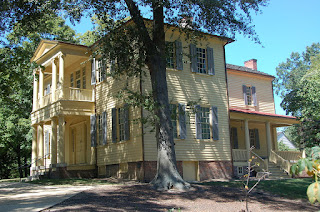 |
| Photo courtesy of Mark Turner - Public Domain |
Built in 1785, the Mordecai house is located in the heart of downtown Raleigh. Once part of a thriving plantation, it is one of the oldest homes in the area. Historic outbuildings include the Badger-Iredell Law Office, the overseer's office and smokehouse, the Allen Kitchen, St. Mark's Chapel, and the Andrew Johnson house; birthplace of the 17th President, Andrew Johnson.
The ghost who inhabits the Mordecai house is said to be the spirit of Mary Willis Mordecai Turk, who lived from 1858 to 1937. She appears wearing a grey 19th-century dress, and can occasionally be heard playing the piano in the downstairs drawing room. Some visitors have also reported seeing a grey mist hovering near the piano. The Mordecai house is filled with original furnishings and many family portraits. It is said that any unkind remarks directed towards Mary's portrait will result in the portrait dropping from the wall. During a field trip, a child claimed they'd seen a man appear and disappear by the Andrew Johnson house. The child became so inconsolable, that they had to be taken back to the school. There have been many investigations on the property - all resulting in impressive evidence of paranormal activity.
The city of Raleigh hosts a family-friendly Haunted Mordecai Festival every October.
Year-round tickets for a guided tour of the home may be purchased at the Visitor Center.
Governor’s Mansion
This Victorian-style mansion has been called home by North Carolina governors since 1891. It was once described by President Franklin Delano Roosevelt as having “the most beautiful governor’s residence interior in America.” The mansion was built from native materials and occupied by 28 governors’ families throughout North Carolina's history. It is also reputedly haunted.
Year-round tickets for a guided tour of the home may be purchased at the Visitor Center.
 |
| Photo courtesy of Mark Turner - Public Domain |
This Victorian-style mansion has been called home by North Carolina governors since 1891. It was once described by President Franklin Delano Roosevelt as having “the most beautiful governor’s residence interior in America.” The mansion was built from native materials and occupied by 28 governors’ families throughout North Carolina's history. It is also reputedly haunted.
In 1891, Governor Daniel Fowle gave his carpenters precise measurements to construct a bed for the second-floor bedroom. The bed was constructed and moved into the residence. That same year, Governor Fowle died in the same bed but many have suggested that his spirit remained. In 1970, Governor Bob Scott decided to replace the massive wooden bed with a modern, king-sized bed. The old bed was moved to a room on the third floor, and the new bed put in its place. A short time afterward, the governor was awakened at night by a strange rapping sound coming from the wall where the original headboard had been. The rapping continued for several years, and the family nicknamed the pesky spirit, "Governor Fowle’s Ghost."
When a new administration took over the office, they decided to move the old bed back to its original location on the second floor. The ghost has not been heard from since.
Poole Woods
William Poole was a wealthy mill owner during the Civil War and owned large tracts of wooded land just east of the city. When Union troops marched into Raleigh, a rumor spread that Poole had vast amounts of gold hidden in the woods around his estate. The Union troops confiscated Poole's belongings, including his prized white horse, but the gold was never recovered.
Against Poole's dying wishes, the trees surrounding his mansion were cut down for timber. However, the trees were found to be worthless, having rotted from the inside. Shortly after Poole’s death, a ghostly white horse was spotted along the road in the woods surrounding the mansion.
Poole’s estate house burned to the ground over a century ago. The tract of land can be found between Walnut Creek Amphitheatre and the Neuse River.
When a new administration took over the office, they decided to move the old bed back to its original location on the second floor. The ghost has not been heard from since.
 |
| Photo courtesy of Hans via Pixabay - CC0 Public Domain |
William Poole was a wealthy mill owner during the Civil War and owned large tracts of wooded land just east of the city. When Union troops marched into Raleigh, a rumor spread that Poole had vast amounts of gold hidden in the woods around his estate. The Union troops confiscated Poole's belongings, including his prized white horse, but the gold was never recovered.
Against Poole's dying wishes, the trees surrounding his mansion were cut down for timber. However, the trees were found to be worthless, having rotted from the inside. Shortly after Poole’s death, a ghostly white horse was spotted along the road in the woods surrounding the mansion.
Poole’s estate house burned to the ground over a century ago. The tract of land can be found between Walnut Creek Amphitheatre and the Neuse River.
______________________________
No comments:
Post a Comment